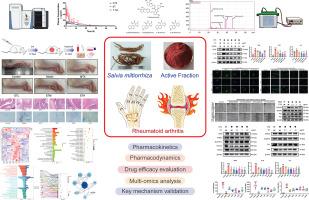Integrative multi-omics reveals that Salvia miltiorrhiza active fraction ameliorates rheumatoid arthritis in rats via inhibiting inflammation and ferroptosis
IF 8.3
1区 医学
Q1 CHEMISTRY, MEDICINAL
引用次数: 0
Abstract
Background
Rheumatoid arthritis (RA) is a chronic, highly disabling autoimmune disease requiring lifelong management, yet current therapies carry substantial long-term toxicity and high costs. Salvia miltiorrhiza is used clinically in the treatment of RA due to its pharmacological properties such as promoting blood circulation, removing blood stasis, and anti-inflammatory effects. However, the specific active fraction of Salvia miltiorrhiza responsible for its therapeutic effect on RA and the underlying mechanism remains unclear.
Objective
To explore active fraction from Salvia miltiorrhiza for the treatment of RA and elucidate their underlying mechanisms.
Methods
The active fraction of Salvia miltiorrhiza was screened via in vitro anti-inflammatory assay and in vivo pharmacokinetic evaluation. The composition was analyzed using UHPLC-Q Exactive-MS/MS and HPLC. An in vivo model of RA was established in rats using the collagen-induced arthritis (CIA) method. Therapeutic effects were assessed by RT-qPCR, Western Blot, and ELISA. Mechanisms were predicted via multi-omics analysis and validated using Western Blot, immunofluorescence, RT-qPCR, and fluorescent probes.
Results
One ethyl acetate extract (named ET) was identified as the active fraction from Salvia miltiorrhiza. In RA rats, ET treatment significantly delayed disease progression and alleviated pathological manifestations. Multi-omics analysis revealed ET modulated amino acid pathways, and impacted macrophage metabolic, inflammation and ferroptosis pathways. Western Blot, immunofluorescence, and RT-qPCR showed that ET not only directly inhibited macrophage inflammatory responses but also indirectly suppressed the activation of fibroblast-like synoviocytes by regulating macrophages. At the same time, ET effectively blocks the ferroptosis process by simultaneously regulating lipid peroxidation and antioxidant signaling. Furthermore, ET's five principal compounds, salvianolic acid B (SalB), dihydrotanshinone I (DIH), cryptotanshinone (CTS), tanshinone I (TanI), and tanshinone IIA (TanIIA), demonstrated inhibitory effects on both inflammation and ferroptosis.
Conclusion
The Salvia miltiorrhiza active fraction ET ameliorates RA pathology by simultaneously regulating inflammation, ferroptosis, amino acid metabolism and synoviocyte dysregulation, demonstrating significant therapeutic potential for RA treatment.

综合多组学研究表明,丹参活性组分通过抑制炎症和铁下垂改善大鼠类风湿关节炎。
背景:类风湿关节炎(RA)是一种慢性、高度致残的自身免疫性疾病,需要终生治疗,但目前的治疗方法具有严重的长期毒性和高成本。丹参因其活血化瘀、抗炎等药理作用,被临床用于治疗类风湿性关节炎。然而,丹参对类风湿关节炎治疗作用的具体活性部位及其作用机制尚不清楚。目的:探索丹参有效部位对类风湿关节炎的治疗作用并探讨其作用机制。方法:通过体外抗炎试验和体内药动学评价筛选丹参有效部位。采用UHPLC-Q - Exactive-MS/MS和HPLC对其成分进行分析。采用胶原诱导关节炎(CIA)方法建立大鼠体内RA模型。采用RT-qPCR、Western Blot、ELISA检测治疗效果。通过多组学分析预测其机制,并使用Western Blot、免疫荧光、RT-qPCR和荧光探针进行验证。结果:鉴定出一种乙酸乙酯萃取物为丹参活性部位。在RA大鼠中,ET治疗可显著延缓疾病进展并减轻病理表现。多组学分析显示,ET调节氨基酸通路,影响巨噬细胞代谢、炎症和铁死亡通路。Western Blot、免疫荧光、RT-qPCR结果显示,ET不仅能直接抑制巨噬细胞的炎症反应,还能通过调节巨噬细胞间接抑制成纤维细胞样滑膜细胞的活化。同时,ET通过同时调节脂质过氧化和抗氧化信号,有效阻断铁下垂过程。此外,ET的五种主要化合物,丹酚酸B (SalB),二氢丹参酮I (DIH),隐丹参酮(CTS),丹参酮I (TanI)和丹参酮IIA (TanIIA),都显示出对炎症和铁下垂的抑制作用。结论:丹参活性部位ET通过同时调节炎症、铁下垂、氨基酸代谢和滑膜细胞失调,改善RA病理,具有显著的治疗潜力。
本文章由计算机程序翻译,如有差异,请以英文原文为准。
求助全文
约1分钟内获得全文
求助全文
来源期刊

Phytomedicine
医学-药学
CiteScore
10.30
自引率
5.10%
发文量
670
审稿时长
91 days
期刊介绍:
Phytomedicine is a therapy-oriented journal that publishes innovative studies on the efficacy, safety, quality, and mechanisms of action of specified plant extracts, phytopharmaceuticals, and their isolated constituents. This includes clinical, pharmacological, pharmacokinetic, and toxicological studies of herbal medicinal products, preparations, and purified compounds with defined and consistent quality, ensuring reproducible pharmacological activity. Founded in 1994, Phytomedicine aims to focus and stimulate research in this field and establish internationally accepted scientific standards for pharmacological studies, proof of clinical efficacy, and safety of phytomedicines.
 求助内容:
求助内容: 应助结果提醒方式:
应助结果提醒方式:


